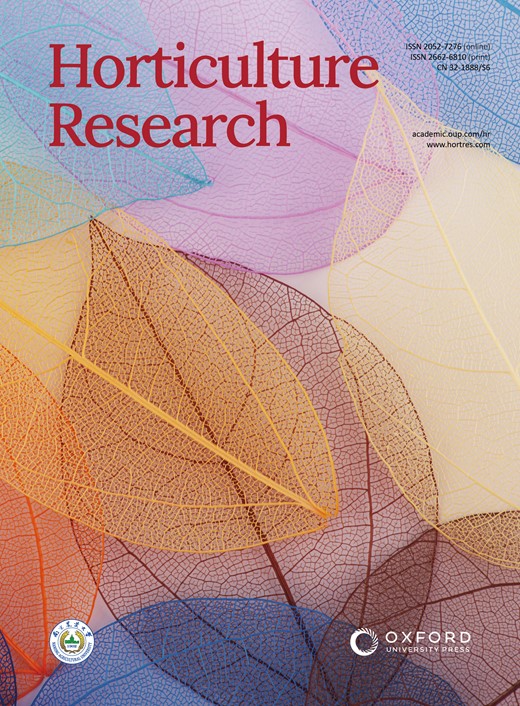Two novel alleles of the MYB transcription factor BjA06.GL1 and BjB02.GL1 control leaf trichomes and enhance resistance to aphids in Brassica juncea
IF 8.7
1区 农林科学
Q1 Agricultural and Biological Sciences
引用次数: 0
Abstract
Leaf trichome formation is a very important agronomic trait as it confers resistance to biotic and abiotic stresses, but the causal genes involved in this process in B. juncea remain largely unexplored. In this study, we first characterized the haplotypes of BjB02.GL1 among different inbred lines with leaf trichomes or glabrous leaves. A comparative analysis of the number and density of leaf trichomes between the two mustard inbred lines was then performed. BSA analysis of leaves with trichomes and glabrous pools from the F2 segregating population mapped the candidate genes on Chr.A06 and Chr.B02. Two candidate genes, BjA06.GL1 and BjB02.GL1, were subsequently cloned. After sequence alignment of the BjGL1 genes, both SNPs and indel were identified in the BjA06.GL1 and BjB02.GL1 genes. And qRT–PCR analysis further confirmed that both the BjA06.GL1 and BjB02.GL1 genes were more highly expressed in leaves with trichomes than in glabrous leaves. As the leaf size increased, the leaf trichome density decreased. Gene editing of both BjA06.GL1 and BjB02.GL1 changed the leaf trichome to a glabrous leaf phenotype in mustard. In addition, plants with leaf trichomes presented greater resistance to aphids. Taken together, our results revealed that both BjA06.GL1 and BjB02.GL1 positively regulate leaf trichome formation and help increase aphid resistance in mustard. This study provides valuable resources and helps to elucidate the molecular mechanism of leaf trichome formation in B. juncea.MYB转录因子BjA06.GL1和BjB02.GL1的两个新等位基因控制叶片毛状体并增强芥蓝对蚜虫的抗性
叶片毛状体的形成是一个非常重要的农艺性状,因为它赋予了对生物和非生物胁迫的抗性,但在君子兰(B. juncea)中,参与这一过程的致病基因在很大程度上仍未被探索。在这项研究中,我们首先鉴定了具有叶毛或无毛叶片的不同近交系中 BjB02.GL1 的单倍型。然后对两个芥菜近交系之间叶片毛状体的数量和密度进行了比较分析。对 F2 分离群体中带有毛状体和无毛叶的叶片进行 BSA 分析,将候选基因绘制在 Chr.A06 和 Chr.B02 上。随后克隆了两个候选基因 BjA06.GL1 和 BjB02.GL1。对 BjGL1 基因进行序列比对后,在 BjA06.GL1 和 BjB02.GL1 基因中发现了 SNPs 和 indel。qRT-PCR分析进一步证实,BjA06.GL1和BjB02.GL1基因在有毛叶中的表达量高于无毛叶。随着叶片大小的增加,叶片毛状体的密度降低。对 BjA06.GL1 和 BjB02.GL1 进行基因编辑后,芥菜的叶片毛状体表型变为无毛。此外,有叶毛的植株对蚜虫有更强的抵抗力。综上所述,我们的研究结果表明,BjA06.GL1 和 BjB02.GL1 都能积极调控叶片毛状体的形成,并有助于提高芥菜的抗蚜性。这项研究提供了宝贵的资源,有助于阐明芥菜叶片毛状体形成的分子机制。
本文章由计算机程序翻译,如有差异,请以英文原文为准。
求助全文
约1分钟内获得全文
求助全文
来源期刊

Horticulture Research
Biochemistry, Genetics and Molecular Biology-Biochemistry
CiteScore
11.20
自引率
6.90%
发文量
367
审稿时长
20 weeks
期刊介绍:
Horticulture Research, an open access journal affiliated with Nanjing Agricultural University, has achieved the prestigious ranking of number one in the Horticulture category of the Journal Citation Reports ™ from Clarivate, 2022. As a leading publication in the field, the journal is dedicated to disseminating original research articles, comprehensive reviews, insightful perspectives, thought-provoking comments, and valuable correspondence articles and letters to the editor. Its scope encompasses all vital aspects of horticultural plants and disciplines, such as biotechnology, breeding, cellular and molecular biology, evolution, genetics, inter-species interactions, physiology, and the origination and domestication of crops.
 求助内容:
求助内容: 应助结果提醒方式:
应助结果提醒方式:


